Everything you need to Know about ADUs

Until recently, builders primarily used the word ADU as part of their technical vocabulary. The abbreviation for accessory dwelling units has just recently entered the language. Everyone appears to be planning or building an ADU these days. Continue reading if you want to learn more about Encinitas accessory dwelling units.
The demand for ADUs began before the pandemic.
However, COVID-19 heightened this curiosity to a whole different level. After hunkering down and working from home, we’re all attempting to cram many functions into our houses. The potential of having an extra building in the backyard that may contain office space, a gymnasium, or a family gathering area has made ADUs quite appealing to virtually everyone.
Looking to know what the whole hype is about?
We’ve broken down all you need to understand about ADUs below.
What are ADUs?
ADU is an abbreviation for Accessory Dwelling Unit, and that is a secondary or extra dwelling unit on a single property behind the principal construction.
You can construct ADUs on the very same property as solitary homes, housing developments, and other types of residential constructions. You can also carve an Accessory Dwelling Unit out of a garage that has been renovated into a living space (with the necessary construction and safety approvals).
Where can you build ADUs?
The legislation passed by the state allows for the construction of ADUs everywhere in the state, irrespective of what the local municipal ordinance says.
There may be municipal regulations that control ADUs (for example, offset requirements, indicating how near to the site boundary you may construct) but individual localities CANNOT ban you from building an ADU provided the lot fulfills the state’s criteria.
What are the many kinds of Accessory Dwelling Units?
We can classify ADUs into three types:
Site built:
It is a conventional construction method, during which a builder transports the raw materials to the site and builds the house from scratch.
Manufactured:
Constructed off-site in a facility, shipped to the site, and erected on a firm foundation built before transferring the manufactured ADU.
Garage conversion:
The transformation of a preexisting structure into a living area after getting the required construction and safety approvals from the local legislative agency.
What are the advantages of constructing an ADU?
The primary benefit is that it provides accommodation to a deserving person or group. The financial rewards will go to the landowner in the form of rental revenue.
Installing an ADU to a home enables a homeowner to have an aging parent close and visible. The extra residence could also allow a college kid to live in the house without sharing a home with their family.
How can I begin the process of constructing an ADU?
Determine what sort of ADU your property is qualified for by consulting with a licensed Encinitas accessory dwelling unit contractor. A specialist will explain the many types and sizes of ADUs that are available.
If you have any concerns regarding your Encinitas accessory dwelling unit, kindly contact our experts at House to Home.